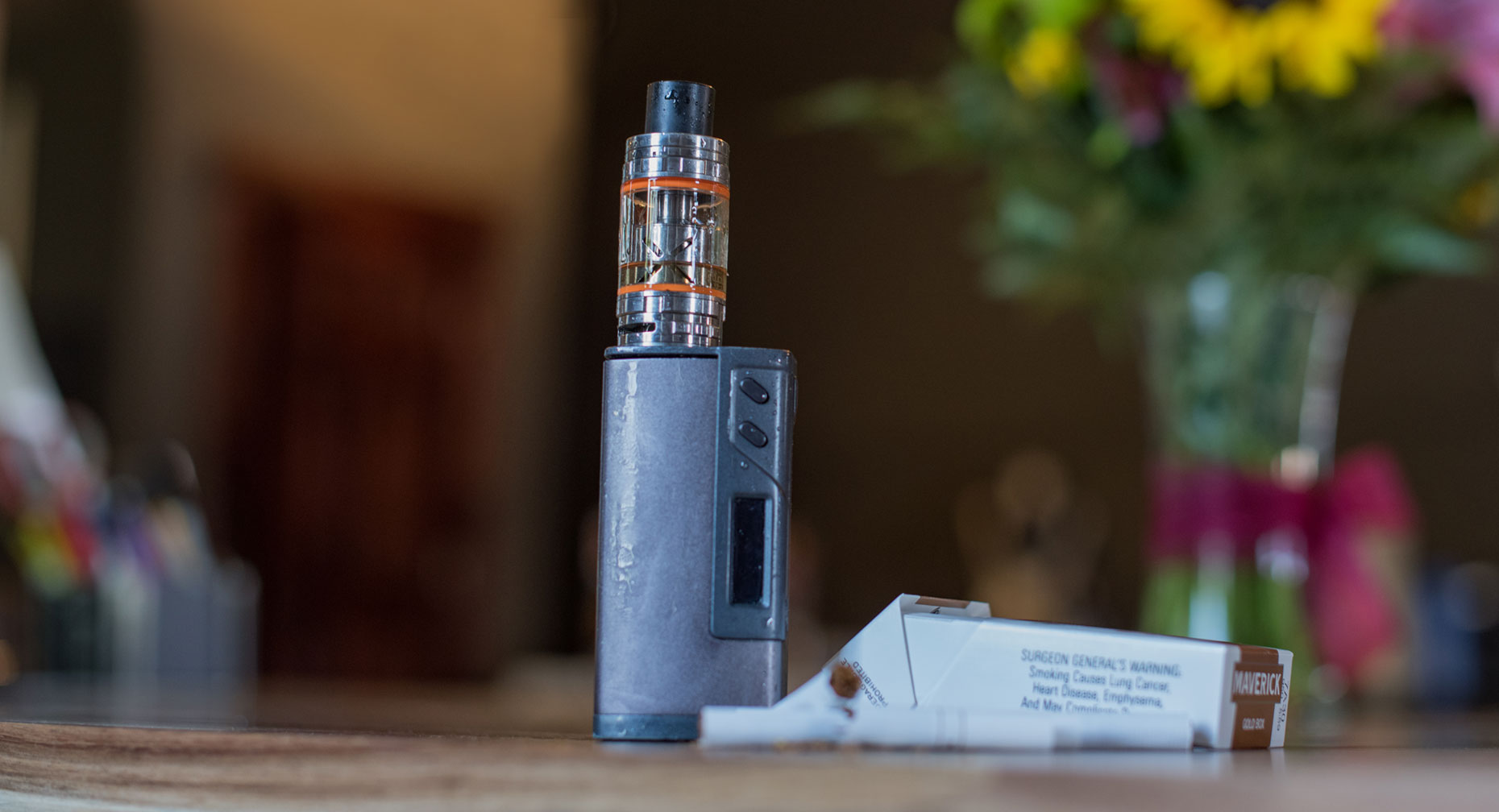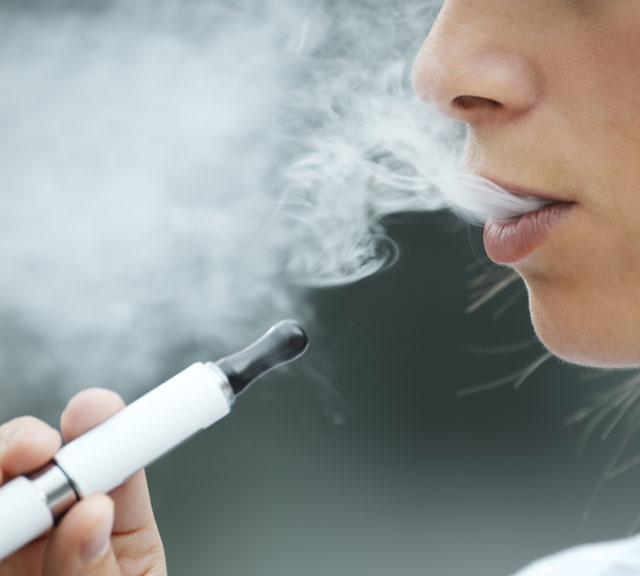Know the Facts About Vaping and E-Cigarettes

Find Your Perfect Match
Answer a few questions and we'll provide you with a list of primary care providers that best fit your needs.
Let’s clear the air about “vaping,” the latest trend in tobacco use.
These electronic cigarettes (e-cigs) are battery-operated devices that heat a liquid containing nicotine, flavors and other chemicals to produce vapor. Users inhale the vapor like cigarette smoke, and the nicotine is absorbed into the lungs.
There is no burning tobacco. There is no smoke. That, say proponents, makes e-cigs safer than cigarettes. They also tout e-cigs as a way to help you quit smoking.
Not so fast, say health professionals and scientists who still are working to understand e-cigarettes and are concerned about the use of e-cig products and their safety.
“This is a controversial topic,” says Soumitra Sen, MD, with Pulmonary and Critical Care Consultants. “I agree with the many health professionals who cite a lack of evidence that electronic cigarettes are safe. In fact, there is evidence that electronic cigarettes are harmful and expose the user to carcinogens.”
There also is evidence that e-cigs and vaping are not effective ways to stop smoking – and that growing use among teens serves as a gateway to cigarettes and other tobacco products.
What Are E-Cigarettes?
E-cigs are also called electronic nicotine delivery systems (ENDS). They are customizable in many ways, including a variety of flavorings. Most e-cigs have three parts:
- Cartridge. This holds the liquid, which includes nicotine, flavorings and other chemicals.
- Heating device. When activated, the heating device turns the liquid into vapor.
- Power source. Most e-cigarettes operate with a battery.
Many electronic cigarette devices are on the market today – 500 brands and 7,700 flavors, says the American Lung Association. Based on how they look and operate, e-cigs may be first, second or third generation products, says Dr. Sen.
- First generation e-cigs. Similar to cigarettes in size and shape.
- Second generation e-cigs. Come in pen-like or tank style with rechargeable batteries and an activation switch to regulate the frequency and power of the vapor.
- Third generation e-cigs. Similar to the second-generation products, with extra customizable features to adjust the amount of vapor inhaled.
Vaping and e-cigs are quickly catching on. In 2014, nearly 4 percent of U.S. adults used e-cigs daily, says the U.S. Food and Drug Administration. The American Lung Association calculates the use of e-cigs by young people exploded between 2011 and 2015, growing by 900 percent.
Their popularity has led manufacturers to make other devices that look like and mimic other types of smoking, including cigars and pipes. E-cigars are often wrapped in a real tobacco leaf and have a glowing tip covered by fake ash.
Some e-cigs look like pens or USB memory sticks making it easier for people to use them in places where smoking is not allowed. “Vape pens” and “e-hookahs” vaporize nicotine solutions flavored like fruit and candy, which appeal to youth.
Safer Than Smoking Real Cigarettes?
When you use e-cigs, you are exposed to some of the same byproducts known to cause tobacco-related diseases but in lesser amounts, says Dr. Sen. Smoking exposes users to tobacco tar, oxidant gases and carbon monoxide. And remember, cigarette smoking is the No. 1 cause of lung cancer.
“There is an assumption that electronic cigarettes may be less harmful than smoking traditional cigarettes,” says Dr. Sen.
However, e-cigs also expose users to additional chemicals such as propylene glycol and glycerol, which break down into known carcinogens. And FDA studies on some e-cig brands found:
- An ingredient used in anti-freeze
- Formaldehyde, a carcinogen
- Diacetyl, a butter flavored chemical known to cause irreversible lung disease
Dr. Sen says the effect of long-term exposure to these agents is not known. “My medical opinion is that more evidence is required to determine if electronic cigarettes are less harmful than traditional cigarettes.”
Health Hazards of Vaping
The FDA started regulating e-cigarettes under the Family Smoking Prevention and Tobacco Control Act in August 2016. The FDA is evaluating all e-cigarette brands to learn exactly what chemicals and products are used in the cartridges and flavorings.
What we do know is that e-cigs contain nicotine. Nicotine causes the feel-good effects of smoking. It is also an addictive and unsafe substance. Nicotine exposure can:
- Harm the brain and lungs of a developing fetus
- Affect maternal and fetal health during pregnancy
- Result in low birth weight, pre-term delivery, stillbirth
- Cause sudden infant death syndrome
- Impact adolescent brain development
- Impede cognitive and behavioral brain development
- Affect working memory and attention
Large doses of nicotine can lead to poisoning with symptoms of nausea, vomiting, seizures and difficulty breathing. Taken in large quantities, nicotine can be lethal, says Dr. Sen.
People who use e-cigs also complain of symptoms of nausea, vomiting, headache, choking and upper airway irritation. E-cig vapor directly affects the lining of the airways, says Dr. Sen and can cause short-term lung changes similar to those caused by regular cigarettes.
Non-vapers should be aware of secondhand exposure. The Surgeon General says emissions from vaping are not harmless and contain cancer-causing chemicals.
“All of this taken together strongly suggests that the use of electronic cigarettes is harmful to the lung,” says Dr. Sen. “And to re-iterate, there is no long-term data to determine if these by-products of electronic cigarettes are safe.”
There are also safety concerns about how the e-cigs work. There are reports of e-cigs catching on fire, causing burns and dangerous exposure to toxins if you refill a cartridge on your own.
Growing Use Among Teens
The FDA estimates more than 3 million high school and middle school students are vaping.
In December 2016 the U.S. Surgeon General declared e-cig use among youth a significant public health concern and says that parents, educators and policymakers should take steps to discourage vaping.
Studies show that young people who use e-cigs also smoke real cigarettes at the same time, or later in their lives.
A 2015 report in the Journal of the American Medical Association followed 2,530 ninth grade students in California who had never used a traditional cigarette. After six months:
- 31 percent who used electronic cigarettes were likely to use traditional cigarettes
- 8 percent of nicotine-free students were likely to use e-cigs
E-cig use among middle and high school students tripled between 2013 and 2014, says the Centers for Disease Control and Prevention. The increase represents the first time since 2011 that current e-cigarette use surpassed current use of every other tobacco product overall, including regular cigarettes.
What’s driving e-cig use among teens? Appealing flavors is the reason given by 81 percent of young e-cigarette users, says the FDA.
When you use e-cigs, you are exposed to some of the same byproducts known to cause tobacco-related diseases but in lesser amounts.
Can E-Cigs Help You Quit Smoking?

Many e-cigarette makers say their product is a tool to help you quit smoking. Electronic cigarettes are not FDA approved as smoking cessation aids, says Dr. Sen.
In fact, many e-cig users continue to vape while also smoking regular cigarettes. In 2015, 58.8 percent of the people who recently used e-cigarettes also currently smoked conventional cigarettes, says the American Lung Association.
“There is no strong data to support the use of electronic cigarettes to help you quit smoking,” says Dr. Sen.
A New Zealand study compared three smoking cessation aids in 657 smokers who wanted to quit:
- Nicotine-containing e-cigs
- Nicotine-free e-cigs
- Nicotine patch
After six months, the smoking cessation rate did not differ significantly among the three groups, says Dr. Sen. That fact, combined with the known health hazards of e-cigarettes, do not support using them as a tool to quit smoking, he reiterates.
There are proven methods to help people quit, including pure forms of inhalable nicotine as well as nasal sprays, gums, lozenges and patches. There are also FDA-approved medications to help free patients from tobacco, says Dr. Sen. “These agents should be used as first-line measures for smoking cessation after talking with your physician.”
Find Your Perfect Match
Answer a few questions and we'll provide you with a list of primary care providers that best fit your needs.
Source: Soumitra Sen, MD, Pulmonary and Critical Care Consultants; National Institute on Drug Abuse, American Cancer Society, American Lung Association, U.S. Food and Drug Administration, Centers for Disease Control and Prevention, U.S. Surgeon General, J





